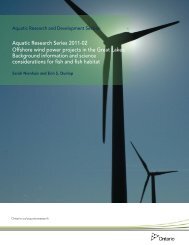(Castanea dentata) in Ontario - Ministry of Natural Resources ...
(Castanea dentata) in Ontario - Ministry of Natural Resources ...
(Castanea dentata) in Ontario - Ministry of Natural Resources ...
You also want an ePaper? Increase the reach of your titles
YUMPU automatically turns print PDFs into web optimized ePapers that Google loves.
Recovery Strategy for the American Chestnut <strong>in</strong> <strong>Ontario</strong><br />
The distribution <strong>of</strong> these populations was estimated to comprise 3.9 percent <strong>of</strong> the total<br />
area <strong>of</strong> distribution <strong>of</strong> American Chestnut <strong>in</strong> North America. The blight entered North<br />
America from Asia at New York City around 1904 (Gravatt and Gill 1930). By the mid-<br />
1940s, the <strong>Ontario</strong> populations <strong>of</strong> American Chestnut were devastated and decl<strong>in</strong>ed<br />
dramatically. In 1947, sprouts that had regenerated from trees killed by blight were<br />
“common everywhere” but no liv<strong>in</strong>g mature trees bear<strong>in</strong>g nuts were found (Fox 1949).<br />
There is little quantitative <strong>in</strong>formation on the decl<strong>in</strong>e <strong>of</strong> established populations <strong>of</strong><br />
American Chestnut s<strong>in</strong>ce the <strong>in</strong>itial pandemics <strong>of</strong> chestnut blight. Surveys conducted <strong>in</strong><br />
recent years are not comparable because <strong>of</strong> differences <strong>in</strong> methodologies, but a<br />
standardized survey protocol developed <strong>in</strong> consultation with the American Chestnut<br />
Recovery Team, was described by T<strong>in</strong>dall et al. (2004) and will enable such<br />
comparisons <strong>in</strong> the future. The most recent survey <strong>of</strong> American Chestnut populations <strong>in</strong><br />
<strong>Ontario</strong> located 601 mature and immature <strong>in</strong>dividuals (T<strong>in</strong>dall et al. 2004). In this<br />
survey, blight symptoms occurred on 25 percent <strong>of</strong> all trees and <strong>in</strong> 48 <strong>of</strong> the 94 locations<br />
<strong>in</strong>spected. The number <strong>of</strong> cankers on <strong>in</strong>fected trees averaged 5.7 (ranged from one to<br />
40) and this was <strong>of</strong>ten associated with the presence <strong>of</strong> epicormic shoots. Individuals<br />
without blight had significantly smaller mean diameter at breast height (DBH; 12.0 cm)<br />
than trees with blight (16.9 cm) (T<strong>in</strong>dall et al. 2004). Mean height for trees without and<br />
with blight was 8.3 m and 9.0 m, respectively. Because T<strong>in</strong>dall et al. (2004)<br />
concentrated heavily on forested public lands and frequently did not sample all trees<br />
with<strong>in</strong> any given location, this is likely only 30 to 70 percent <strong>of</strong> the estimated total<br />
population.<br />
Ambrose and Aboud (1986) reported seedl<strong>in</strong>gs <strong>in</strong> 7 <strong>of</strong> 62 sites, whereas T<strong>in</strong>dall et al.<br />
(2004) found none with<strong>in</strong> a 20 m radius <strong>of</strong> trees <strong>in</strong> 93 locations. Low recruitment is due,<br />
<strong>in</strong> part, to the fact that few regenerat<strong>in</strong>g sprouts survive until reproductive age. The<br />
survey by T<strong>in</strong>dall et al. (2004) found that nearly 50 percent <strong>of</strong> all trees exam<strong>in</strong>ed had a<br />
DBH greater than 10 cm and 80 percent were less than 20 cm. Only 14 percent were<br />
reproductive (i.e., produced catk<strong>in</strong>s or burrs) and no trees were observed with viable<br />
seeds (i.e., filled nuts). Low reproductive success <strong>in</strong> otherwise healthy trees may be<br />
related to the fact that these trees are <strong>of</strong>ten geographically isolated and therefore, rarely<br />
cross-poll<strong>in</strong>ate.<br />
In 1985, McKeen reported that 60 trees, rang<strong>in</strong>g <strong>in</strong> DBH from 8 to 63 cm, were present<br />
with<strong>in</strong> the orig<strong>in</strong>al range. Other surveys by Ambrose and Aboud (1986) and Boland et<br />
al. (1997) reported 151 trees over 10 cm DBH, plus numerous uncounted smaller stump<br />
sprouts and 297 <strong>in</strong>dividuals, respectively. These surveys differed <strong>in</strong> objectives, search<br />
<strong>in</strong>tensity and procedures and, hence, the values estimated from the three studies are<br />
not comparable and likely do not reflect a population trend. Derivation <strong>of</strong> a population<br />
estimate for the total number <strong>of</strong> chestnut stems <strong>in</strong> North America was precluded by<br />
miss<strong>in</strong>g data from the United States (McWilliams et al. 2005).<br />
7
















